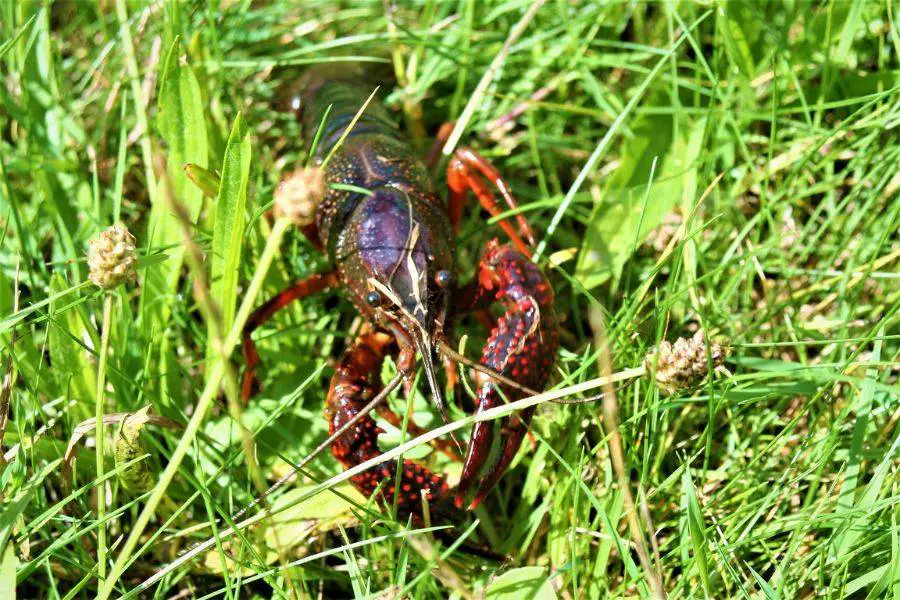Table of Contents
One of the natural behavior of Crawfish is to dig underground tunnels called Burrows.
This is where you’ll mostly find them and also around freshwater like rivers, lakes, and swamps.
Crawfish burrows are not very pleasing to look at.

The mud towers that they create when building these holes can disfigure your yard.
If you’ve ever experienced this problem or simply want to hunt crawfish for fun, getting them out of their holes can prove tricky.
This article, however, will give you complete information about Crawfish and a guide on the best ways to get them out of their hole.
Things You Need to Know Before Catching Crawfish
- It is easier to get them out of their holes at night: Being nocturnal creatures, Crawfish do most of their activities at night. So, around this time, they are in or around their burrows. It is the perfect time to reach them. However, this is not to say that you cannot get them out of their hole during the day, because with a juicy bait, you can get their attention even when they are deep in the ground and inactive.
- You’ll find them in Freshwater: These Crustaceans like to dig their hole close to freshwater bodies like lakes, rivers, streams, etc. They will also burrow around rocks and moist places that offer shade for their activities.
- You’ll need an attractive Bait: Few things can get the attention of Crawfish like juicy bait. Hot on their menu is fresh meat or small fish like herring, trout, and salmon. Some people have explained that rubbing the bait in oil gets the job done faster.
How to Make the Perfect Bait to Draw Crawfish Out of Their Hole
For this, you’ll need a fishing pole, a fishhook, bait, a rod, and bait.
First, fasten the bait, preferably a small fish dipped in oil, to the fishing line using the hook.
The bait should be knotted inside the hook end to ensure that it doesn’t fall off when the Crawfish is tugging at the line.
After you’ve created the bait, you’re now ready to catch the crawfish.
Step-By-Step Guide on How to Get Crawfish Out of Their Hole
Step 1: Identify Where the Crawfish Have Dug up a Hole
Already established, Crawfish like to make burrows in the ground near freshwater bodies for easy access to the water table.
They prefer streams, rivers, lakes, spring water, ponds, and also canals.
These crustaceans also survive better around low water pressure or still water.
For this reason, you’ll find them on the edge of the water body.
Places with stones, rocks, and vegetation to give them cover.
You can identify a Crawfish burrow by the distinct heap of mud that is stacked around the entrance.
The mud tower disguises the depth of the crawfish hole.
Once you have located the Crawfish burrow, you are now ready for step two.
Step 2: Clear out the heap of mud at the Entrance
It’s unclear if it is by Crawfish design and some sort of distraction mechanism but people usually mistake the hardened mound on top of the other Crawfish hole as their safe ground.
That’s so wrong.
The heap of mud is just the beginning and after clearing it out, you will have access to the entrance of the Crawfish fortress that could go very deep into the ground.
When they burrow, Crawfish can dig tunnels up to 5 feet into the ground, and they create this transportation network to easily access the water table and to hide from predators.
Step 3: Fill the Hole With Water
Typically, you’ll find that the crawfish hole is dry and has channels that lead underground to various places.
When you fill the hole with water, you might gain the attention of the Crawfish with this unexpected event.
If you’re lucky, they will try to find out the cause of the disturbance, and soon enough, you’ll see a red lobster-like creature rear its head out of the hole.

You can make your move then.
If they are reluctant to come out, it’s time to initiate step 4.
Also, contrary to some opinion, pouring hot water into the Crawfish hole won’t hasten the process.
There is, so far, no accurate measure to determine if it works or not.
Step 4: Lower the Bait
Once you have secured the bait to the fish trap and the Crawfish hole is flushed with water, lower the trap into the water as deep as you can reach.
Ensure that there is enough fishing line above the hole so that you can easily pull when the time comes. Shake the bait repeatedly until you feel a pull at the bottom.
There’s a good chance you’ve just caught a Crawfish, so, gently move the trap up and remove the Crawfish from the trap.
There are various types of traps to catch Crawfish depending on the volume required.
A simple fishhook is adequate to catch a few of the lobster-like creatures.
However, if you intend to do Crawfish catching on a large scale, you will need a bigger trap.
Alternative Open/Closed Traps to Get Crawfish Out of Their Hole
A small fishhook trap is great if you are hunting Crawfish sparingly or for fun.
If you intend to scale up, however, you will need a bigger trap.
Asides from a hook, there are also open and closed traps for catching Crawfish.
Open traps, as the name suggests are open on one end and easily collapsible to catch a large quantity of Crawfish swiftly.
The closed trap operates through a slightly different mechanism.
There is an open funnel at one end of the trap that enables the Crawfish to enter the trap but once they are in, it is impossible to get out since all the other sides are closed.
With the closed traps, you may not need close supervision and can simply leave it in the water for hours or overnight to catch as many Crustaceans as possible.
Similar to the simple fishhook traps, the open and closed traps also need bait to draw out the Crawfish.
You can put the bait inside the traps and leave it in the water whilst you enjoy your time doing something else.
Conclusion
Many species of Crawfish exist in the world.
Although they all have similar appearance and structure, they are distinct in color, size, eating habits, etc.
They are mostly freshwater species and will burrow underground tunnels to easily access the water table.
The depth and intricacy of these tunnels make it very difficult to reach them sometimes without knowing a few tricks here and there.
They are also a very tasty part of cuisine in many places in the world — always hot on the seafood menu.
The Crawfish meat is white and very delicious and juicy!
It can be eaten as part of a larger meal or sucked on its own.
Due to the resemblance in taste, Crawfish is a popular option to replace Crabs or Lobsters in a seafood menu.
This article offers a guide on the best ways to get Crawfish out of their hole if you’re hunting them for food or if you want to drive them out of your yard. Let’s go Crawfish hunting!









